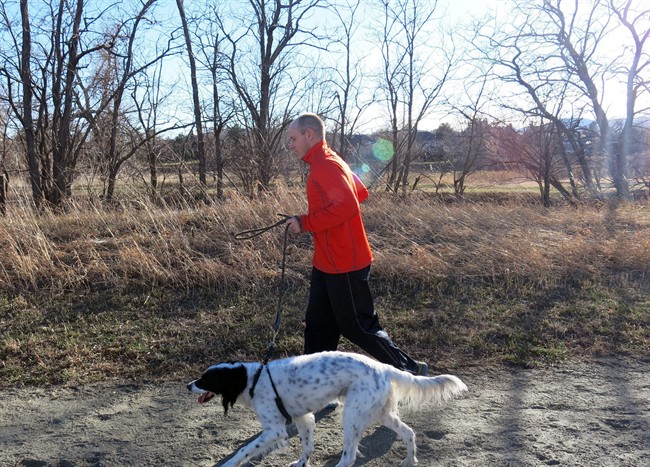When Amanda Tichacek began running eight years ago, she found a friendly sidekick in Roxie, her 2-year-old greyhound mix. They started out slowly, but soon began running longer distances on the wooded trails near their home in Skokie, Illinois.

“We have grown together as runners,” says Tichacek, who now logs 60 to 100 kilometres a week.
In her prime, Roxie ran near-marathon distances, averaging close to 1,000 kilometres a year. Even at age 10, she still can run 10 or more kilometres with her owner.
For many runners, dogs offer companionship and fun. But while dogs clearly love to run, not all are built for long-distance running with people. Don’t push your dog too hard, and stop if you see the dog lagging.
A vet’s advice
Runners who want to share their love of the trail with a dog must consider the animal’s age, breed and fitness, says Dr. Jeff Gerlesits, a veterinarian at Homeward Bound Animal Hospital in Arvada, Colorado. Start by getting the dog a checkup.
“You want to make sure things are at a good starting point,” says Gerlesits. A vet will check for respiratory, cardiovascular and orthopedic issues.
To keep Roxie in running shape, Tichacek keeps her hydrated and well-nourished, and watches for signs of stress.
“When she was younger she was all in and there weren’t any issues,” recalls Tichacek. “As she’s gotten older, if she wants to stop, that’s it. We’re done. You have to do what’s best for the dog.”
Age and breed
Never run with a dog younger than a year, says Gerlesits. Dogs, like humans, have growth plates that need to close before they can safely run beyond a playtime scamper.
Dog breeds reach skeletal maturity at different times, smaller dogs generally faster than larger breeds. “For a Labrador, that’s about 12 months, but for a Great Dane, it’s more like 18 months,” says Gerlesits.
And not all breeds make ideal running partners; for instance, those with squished faces — the technical term is brachycephalic — will have a more difficult time running distances because it’s harder for them to breathe. Those include pugs, bulldogs and boxers.
Better runners include the working and sporting breeds, says Gerlesits, who runs with an English setter. However, he doesn’t rule out any breed completely.
“If we’re aware of a dog’s abilities and slowly work up from there, any dog has potential,” he says.
Building strength and stamina
Catra Corbett of Fremont, California, runs with TruMan, a 10-year-old dachshund. Despite his short legs, he runs over 60 kilometres a week, and has run two 50-kilometre trail races, she says.
TruMan was timid — even afraid of neighbourhood walks — when Corbett rescued him in 2012, so she took him trail running.
“I thought, he will either follow me or run back to the car,” she says.
“I started running and he followed. The trails saved him. He came alive out there.”
Corbett, who writes about their adventures on a blog called Dirt Diva, built up TruMan’s miles slowly. Gerlesits says that’s prudent.
Climate is another factor. Because dogs only sweat through their paws — and cool down via panting — they overheat faster than we do. Gerlesits advises against running a dog in the heat of a summer day, and recommends offering water to a trail-running dog every 30 to 45 minutes at least. Provide food, too; if you need fuel during a long run, so does your dog. Gerlesits recommends a high-protein, high-calorie snack.
“You can tell when you’re pushing your dog too hard — you know your dog. They should be next to you or a little in front, where they like to be,” says Gerlesits. “If your dog is behind you, the workout is too hard.”
Trail etiquette and safety
Tichacek always keeps Roxie leashed and by her side.
“On the single-track trails, you can’t have a dog going nuts,” she says. “I’ve run with friends whose dogs lacked that etiquette, and it’s frustrating.”
Likewise, Gerlesits leashes his dog, Dawson. “It’s in the best interest of your dog, other runners, other dogs and wildlife,” he says.
Many local and state parks require that dogs be leashed, while most national parks exclude dogs from trails altogether. Check a park’s rules before you visit, recommends Ranger Ken Low of the National Park Service.
Low works at the Santa Monica Mountains National Recreation Area, which has 500 miles of trails east of Los Angeles. Longer trails may cross several parklands, each with its own canine rules.
“You need to do your advance homework and make sure dogs are allowed,” he says. “It’s always good to have a leash on you.”
Trail dangers for dogs range from rattlesnakes to poison ivy and poison oak. Horses have the right of way, Low says, and mountain bikers ought to yield to hikers and runners.
For Tichacek, seeing Roxie enjoy the woods is one of the best parts of running together. “It feeds into her natural instinct of being a dog. She gets to climb over rocks and roots and drink from a stream. It brings me such pleasure and happiness to see that she’s having fun.”

Comments